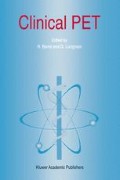Abstract
Positron emission tomography (PET) is continouing to have a major scientific impact on clinical neurology. Its role in routine clinical practice has been restricted by the lack of prospective studies on a large number of patients, mainly due to the restricted availability of PET centres at clinical institutions with access to appropriate patient data bases. However, recent progress has been made in several areas, which should stimulate the formulation of new questions, in which PET might be of major value.
Access this chapter
Tax calculation will be finalised at checkout
Purchases are for personal use only
Preview
Unable to display preview. Download preview PDF.
References
Powers WJ. Cerebral hemodynamics in ischemic cerebrovascular disease. Ann Neurol 1991; 29: 231–240.
Heiss WD, Herholz K. Assessment of pathophysiology of stroke by positron emission tomography. European Journal of Nuclear Medicine 1994; 21: 455–465.
Lassen NA, Olsen TS, Hqjgaard K, Skriver E. Incomplete infarction: A CT negative irreversible ischemic brain lesion. J Cereb Blood Flow Metab 1983; 3, suppl. 1: S602 - S603.
Weiller C, Willmes K, Reiche W, et al. The case of aphasia or neglect after striatocapsular infarction. Brain 1993; 116: 1509–1525.
Garcia JH, Wagner S, Liu KF, Hu XJ. The neurologic deficit and the extent of neuronal necrosis attributable to middle cerebral artery occlusion. Stroke 1995; 26:(în press)
Weiller C, Ringelstein EB, Reiche W, Thron A, Buell U. The large striatocapsular infarct. A clinical and pathophysiological entity. Arch Neurol 1990; 47: 1085–1091.
Sette G, Baron JC, Young AR, et al. In vivo mapping of brain benzodiazepine receptor changes by positron emission tomography after focal ischemia in the anesthetized baboon. Stroke 1993; 24: 2046–2058.
Lassen NA, Bartenstein PA, Lammertsma AA, et al. Benzodiazepine Receptor Quantification In Vivo in Humans Using [11C]Flumazenil and PET: Application of the Steady-State Principle. J Cereb Blood Flow Metab 1995; 15: 152–165.
Weiller C, Chollet F, Friston KJ, Wise RJS, Frackowiak RSJ. Functional reorganization of the brain in recovery from striatocapsular infarction in man. Ann Neurol 1992; 31: 463–472.
Weiller C, Ramsay SC, Wise RJS, Friston KJ, Frackowiak RSJ. Individual patterns of functional reorganization in the human cerebral cortex after capsular infarction. Ann Neurol 1993; 33: 181–189.
Rijntjes M, Weiller C, Krams M, Bauermann T, Diener HC, Faiss J. Functional Magnetic Resonance Imaging in Recovery from Motor Stroke. Stroke 1994; 25: 256. (abstract)
Weiller C, Isensee Ch, Rijntjes M, et al. Recovery from Wemiche’s aphasia - APET study. Ann Neurl 1995;(in press)
Eulitz C, Elbert T, Bartenstein PA, Weiller C, Müller SP, Pantev C. Comparison of magnetic and metabolic brain activity during a verb generation task. Neuro Report 1994; 6: 97–100.
Jørgensen HS, Nakayama H, Raaschou HO, Olsen TS. Effect of blood pressure and diabetes on stroke in progression. Lancet 1994; 344: 156–159.
Powers WJ. Acute hypertension after stroke: The scientific basis for treatment decisions. Neurology 1993; 43: 461–467.
Powers WJ, Tempel LW, Grubb RL. Influence of cerebral hemodynamics on stroke risk: one year follow-up of 30 medically treated patients. Ann Neurol 1989; 25: 325–30.
Weiller C, Ringelstein EB, Reiche W, Buell U. Clinical and hemodynamic aspects of low flow infarcts. Stroke 1991; 22: 1117–1123.
Ad Hoc Committee American Heart Association. Guidelines for Carotid Endarterectomy. Stroke 1995; 26: 188–201.
Vanninen R, Kolvisto K, Tulla H, Manninen J, Partanen K. Hemodynamic Effects of Carotid Endarterctomy by Magnetic Reson a nce Flow Quantification. Stroke 1995; 26: 84–89.
Kleinschmidt A, Steinmetz H, Sitzer M, Merboldt K-D, Frahm J. Magnetic Resonance Imaging of Regional Cerebral Blood oxygenation changes under acetazolamine in carotid occlusive disease. Stroke 1995; 26: 106–110.
Grady CL, Haxby JV, Horwitz B, et al. A longitudinal study of the early neuropsychological and cerebral metabolic changes in dementia of the Alzheimer type. J Clin Exp Neuropsychology 1987; 10: 579–596.
Sabri O, Hellwig D, Kaiser HJ, et al. Einfluss morphologischer Verhinderungen auf Durchblutung and Stoffwechsel bei zerebraler Mikroangiopathie. Nucl Med 1995;
McKhann G, Drachman D, Folstein M, Katzman R, Price D, Stadlan EM. Clinical diagnosis of Alzheimer’s disease: report of the NINCDS- ADRDA work group under the auspices of Department of Health and Human Services Task Force on Alzheimer’s disease. Neurology 1984; 34: 939–944.
Spencer SS. The relative contributions of MRI, SPECT and PET Imaging in Epilepsy. Epilepsia 1994; 35 (suppl. 6): S72 - S89.
Pawlik G, Fink GR, Kessler J, Heiss WD. PET and functional testing in temporal lobe epilepsy. Acta Neurol Scand 1994; Supplement 152: 150–156.
Duncan JS. Discussion. Acta Neurol Scand 1994; Supplement 152: 135–136.
Savic I, Persson A, Roland P, Pauli S, Sedvali G, Widen L. In vivo demonstration of reduced benzodiazepine receptor binding in human epileptic foci. Lancet 1988; 863.
Leblanc R, Meyer E, Bub D, Zatorre Ri, Evans AC. Language localization with activation positron emission tomography. Neurosurgery 1992; 31: 369–373.
Editor information
Editors and Affiliations
Rights and permissions
Copyright information
© 1996 Kluwer Academic Publishers
About this chapter
Cite this chapter
Weiller, C. (1996). PET in Neurology — Clinical Problems. In: Bares, R.B., Lucignani, G. (eds) Clinical PET. Developments in Nuclear Medicine, vol 28. Springer, Dordrecht. https://doi.org/10.1007/978-94-009-0309-8_9
Download citation
DOI: https://doi.org/10.1007/978-94-009-0309-8_9
Publisher Name: Springer, Dordrecht
Print ISBN: 978-94-010-6624-2
Online ISBN: 978-94-009-0309-8
eBook Packages: Springer Book Archive

